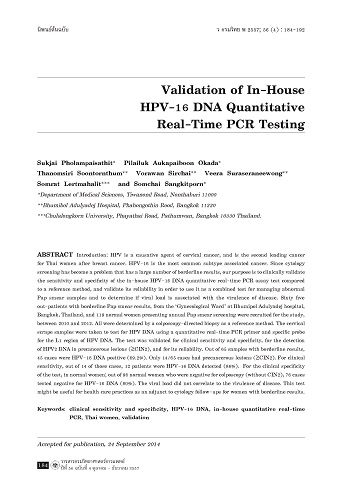Validation of In-house HPV-16 DNA Quantitative Real-time PCR Testing
Keywords:
clinical sensitivity and specificity, HPV-16 DNA, in-house quantitative real-time PCR, Thai women, validationAbstract
Introduction: HPV is a causative agent of cervical cancer, and is the second leading cancer for Thai women after breast cancer. HPV-16 is the most common subtype associated cancer. Since cytology screening has become a problem that has a large number of borderline results, our purpose is to clinically validate the sensitivity and specificity of the in-house HPV-16 DNA quantitative real-time PCR assay test compared to a reference method, and validate its reliability in order to use it as a combined test for managing abnormal Pap smear samples and to determine if viral load is associated with the virulence of disease. Sixty five out-patients with borderline Pap smear results, from the ‘Gynecological Ward’ at Bhumipol Adulyadej hospital, Bangkok, Thailand, and 119 normal women presenting annual Pap smear screening were recruited for the study, between 2010 and 2012. All were determined by a colposcopy-directed biopsy as a reference method. The cervical scrape samples were taken to test for HPV DNA using a quantitative real-time PCR primer and specific probe for the L1 region of HPV DNA. The test was validated for clinical sensitivity and specificity, for the detection of HPV2 DNA in precancerous lesions (≥CIN2), and for its reliability. Out of 65 samples with borderline results, 45 cases were HPV-16 DNA positive (69.2%). Only 14/65 cases had precancerous lesions (≥CIN2). For clinical sensitivity, out of 14 of those cases, 12 patients were HPV-16 DNA detected (86%). For the clinical specificity of the test, in normal women; out of 96 normal women who were negative for colposcopy (without CIN2), 76 cases tested negative for HPV-16 DNA (80%). The viral load did not correlate to the virulence of disease. This test might be useful for health care practices as an adjunct to cytology follow–ups for women with borderline results.
References
WHO. Human papillomavirus (HPV) and cervical cancer. [online] Sep 2013; [cited 2014 Oct 8]; [5 screens]. Available from: URL: http://www.who.int/mediacentre/factsheets/fs380/en/
KhuhapremaT, Attasara P, Sriplung H, Wiangnon S, Sangrajrang S. Cancer in Thailand volume VII, 2007-2009. Bangkok: National Cancer Institute; 2013.
Munoz N, Bosch FX, de Sanjose S, Herrero R, Castellsagou X, Shah KV, et al. Epidemiologic classification of human papillomavirus types associated with cervical cancer. N Engl J Med 2003; 348(6): 518-27.
Poljak M, Cuzick J, Kocjan BJ, Iftner T, Dillner J, Arbyn M. Nucleic acid tests for the detection of alpha human papillomaviruses. Vaccine 2012; 30(Suppl 5): F100-6.
Schutzbank TE, Ginocchio CC. Assessment of clinical and analytical performance characteristics of an HPV genotyping test. Diagn Cytopathol 2012; 40(4): 367-73.
Flanelly G, Jiang G, Anderson D, Melvin W, Mann E, Kitchener H. Serial quantitation of HPV 16 in the smears of women with mild and moderate dyskaryosis. J Med Virol 1995; 47: 6-9.
van Duin M, Snijders PJ, Schrijnemakers HF, Voorhorst FJ, Rozendaal L, Nobbenhuis MA, et al. Human papillomavirus 16 load in normal and abnormal cervical scrapes: an indicator of CIN II/III and viral clearance. Int J Cancer 2002; 98(4): 590–5.
สาธนา โตเจริญวาณิช. การตรวจคัดกรองมะเร็งปากมดลูก. สงขลานครินทร์เวชสาร 2545; 20(2): 137-49.
Linder J, Zahniser D. ThinPrep papanicolaou testing to reduce false-negative cervical cytology. Arch Pathol Lab Med 1998; 122(2): 139-44.
Kulasingam SL, Hughes JP, Kiviat NB, Mao C, Weiss NS, Kuypers JM, et al. Evaluation of human papillomavirus testing in primary screening for cervical abnormalities: comparison of sensitivity, specificity, and frequency of referral. JAMA 2002; 288(14): 1749-57.
Meijer CJ, Berkhof H, Heideman DA, Hesselink AT, Snijders PJ. Validation of high-risk HPV tests for primary cervical screening. J Clin Virol 2009; 46(Suppl 3): S1-4.
Bensal M, Li Z, Zhao C. Correlation of histopathologic/cytologic follow-up findings with vaginal ASC-US and ASC-H Papanicolaou test and HPV test results. Am J Clin Pathol 2012; 137(3): 437-43.
Meijer CJ, Berkhof J, Castle PE, Hesselink AT, Franco EL, Ronco G, et al. Guidelines for human papillomavirus DNA test requirements for primary cervical cancer screening in women of 30 years and older. Int J Cancer 2009; 124(3): 516-20.
Cuzick J, Arbyn M, Sankaranayanan R, Tsu V, Ronco G, Mayrand MH, et al. Overview of human papillomavirus- based and other novel options for cervical cancer screening in developed and developing countries. Vaccine 2008; 26(Suppl 10): K29-41.
Arbyn M, Sasieni P, Meijer CJ, Clavel C, Koliopoulos G, Dillner J. Chapter 9: Clinical applications of HPV testing: a summary of meta-analyses. Vaccine 2006; 24(Suppl 3): S78-89.
Cuzick J, Terry G, Ho L, Hollingworth T, Anderson M. Type-specific human papillomavirus DNA in abnormal smears as a predictor of high-grade cervical intraepithelial neoplasia. Br J Cancer 1994; 69: 167-71.
Tsiodras S, Georgoulakis J, Chranioti A, Voulgaris Z, Psyrri A, Tsivilika A, et al. Hybrid capture vs. PCR screening of cervical human papilloma virus infections. Cytological and histological ssociations in 1270 women. BMC Cancer 2010; 10: 53.
Chaiwongkot A, Pientong C, Ekalaksananan T, Kongyingyoes B, Thinkhamrop J, Yuenyao P, et al. Evaluation of primers and PCR performance on HPV DNA screening in normal and low grade abnormal cervical cells. Asian Pac J Cancer Prev 2007; 8(2): 279-82.
Schmitt M, Depuydt C, Benoy I, Bogers J, Antoine J, Pawlita M, et al. Viral load of high-risk human papillomaviruses as reliable clinical predictor for the presence of cervical lesions. Cancer Epidemiol Biomarkers Prev 2013; 22(3): 406-14.
Zerbini M, Venturoli S, Cricca M, Gallinella G, De Simone P, Costa S, et al. Distribution and viral load of type specific HPVs in different cervical lesions as detected by PCR-ELISA. J Clin Pathol 2001; 54(5): 377-80.

Downloads
Published
How to Cite
Issue
Section
License

This work is licensed under a Creative Commons Attribution-NonCommercial-NoDerivatives 4.0 International License.



